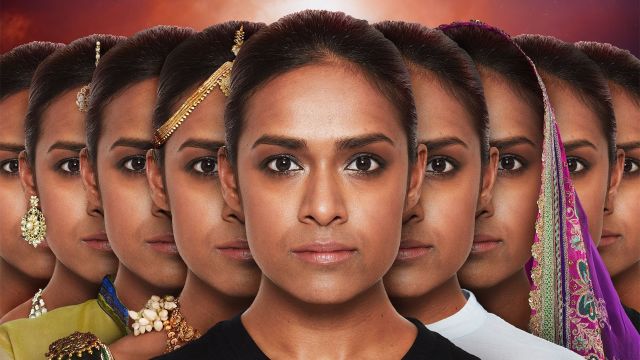
Mahabharata: A Retelling of a 4000 Year Old Family Feud
Mahabharata’s epic journey asks, “When everyone believes they are right and their opponents wrong, how can one end a spiral of revenge?”
Mahabharata, India’s epic tale in Sanskrit is 4000 years old but its story is relevant ever more in today’s challenging world. It is a story heard by Indians from childhood, and has been told and retold by families, made into books, films and serials. At its heart it is about profound spiritual and moral ideals which are universal and touch us all. Now this saga of love and war and family comes to Lincoln Center, brought to life by a full South Asian cast and created in the Diaspora.
Mahabharata is a grand gift from the Lincoln Center for all theater lovers in its Summer for the City programming – it is accessible to all through a pay-what-you-wish ticketing policy. It plays at the Rose Theater from June 24-29 and transports you to India through music, dance, shadow play and spectacle.
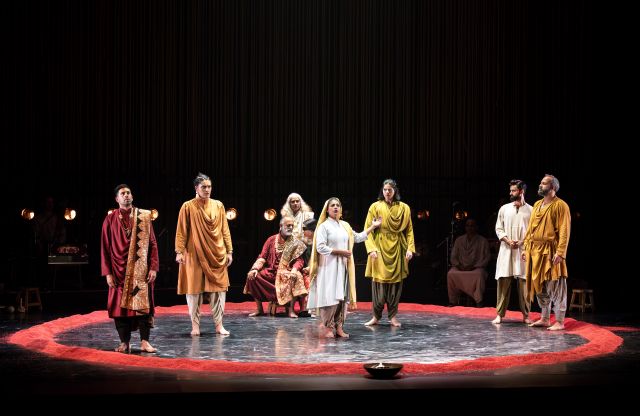
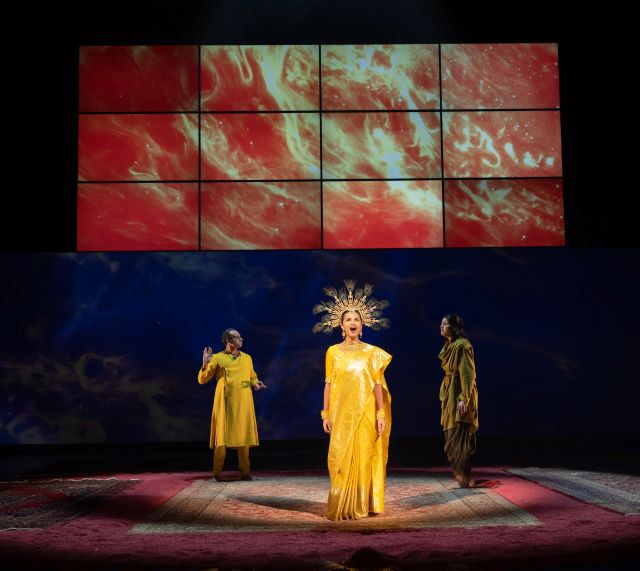
This epic drama is brought to New York by the noted Canadian theater company Why Not Theater, and is created and directed by Ravi Jain and Miriam Fernandes. It is a visually stunning retelling of the Sanskrit epic, with a contemporary take on a family feud. The large-scale narrative is told in two distinct parts—Part One: Karma: The Life We Inherit and Part Two: Dharma: The Life We Choose. Throughout the experience, the production undergoes an evolution in storytelling, from the most ancient and intimate to a contemporary and technologically integrated spectacle.
Mahabharata premiered in 2023 at the Shaw Festival, it played at the UK’s Barbican and recently showed at Australia’s Perth Festival.
Mahabharata is a River of Stories
Ravi Jain – A director’s notes on the making of Mahabharata
Mahabharata was a story that played in the background of my childhood. I caught glimpses of it through a popular television series, a set of comic books, and in the paintings and sculptures of ancient temples I’d visited in India. The characters infiltrated my imagination, but I never really knew the story – only pieces, episodes, the television theme song.
I also knew Mahabharata through different styles of traditional dance. I watched numerous friends’ “dance graduations” where 9 of 10 dances would inevitably be stories from Mahabharata. For thousands of years, it has been told over and over, in many different ways.
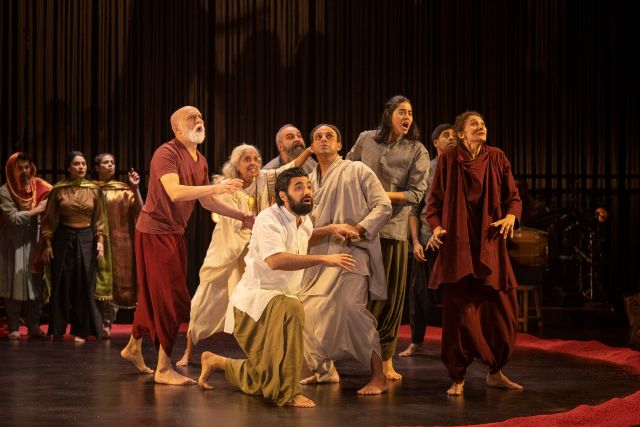
How could we tell Mahabharata today and have its messages resonate with modern audiences? Our team felt that exploring how this story has been told over the centuries was just as important as the story’s plot. Our telling blends traditional and modern, east and west, and includes various forms of Indian dance, storytelling, live music and even a Sanskrit opera! We’ve also tried to mimic many peoples’ real-life experience – receiving these stories, through an interpretation and lesson, over a meal.
Each of these forms of storytelling help to unlock Mahabharata’s meanings – they help us reach beyond words and narrative to access its spiritual and philosophical underpinnings. It’s rare to experience Mahabharata from beginning to end in one day. It needs time. It requires perspective. Its stories stay with you – their contradictions become the subject of conversations and debates, and as we age those meanings change.
Miriam and I have sat with this story for 8 years. The best advice I can give to you is a line from our play’s Storyteller: “Don’t be confused by plots. Within the river of stories flows the infinite wisdom. That is your true inheritance.”
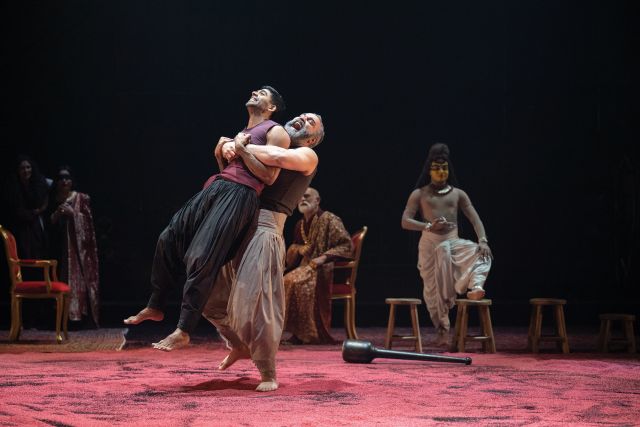
Carving Through a Dense Forest of Stories
Miriam Fernandes and Ravi Jain, co-creators of Mahabharata, on how they did it.
“One of the greatest respites during our journey has been spending time with past tellers of the epic. For thousands of years before the story was written down, it was passed from generation to generation orally, and so, there are as many Mahabharatas as there are storytellers. Assembling this version has been an enormous task of compilation. In compiling Mahabharata, we turned to many sutradhaars, which translates from Sanskrit to “the person that weaves the threads.”
We want to express gratitude to a few key storytellers who have held up lanterns to help us see in the sometimes dark forest. Our love and respect to Sharada K Eswar, Devdutt Pattanaik, Rustom Bharucha, Peter Brook and Jean-Claude Carrière, Rabindranath Tagore, B.R. Chopra, Amar Chitra Katha, and our deepest thanks to Carole Satyamurti, whose poetry and imagination have anchored our journey. We are humbled to be part of this lineage of storytellers, passing the baton of this story on to the next generation. Having spent nearly a decade with this story we have found the revelation of the Mahabharata is to learn not to become distracted by the forest, or concerned with the wind, but to immerse oneself ever deeper into the earth, travelling into the labyrinth of its roots.”
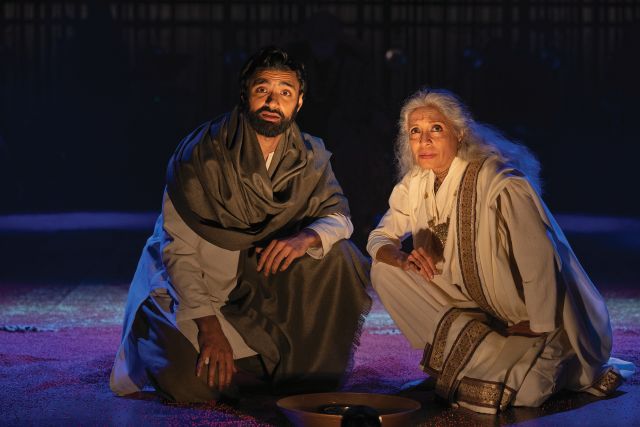
Mahabharata (Photo David Cooper)
Lassi with Lavina’s One-on-One Interview with Shawn Ahmed who plays Yudhishthira in Mahabharata
Yudhishthira – From Idealistic Prince to Weary Philosopher King
Yudhishthira was a hero known for his honesty, justice, sagacity, tolerance, good behavior and discernment. So, what were the special challenges of playing such a paragon of virtue?
You’re right—Yudhishthira is a “paragon of virtue” … at times. But the reality is, none of us are as virtuous as we’d like to be, and Yudhishthira is no exception. The challenge wasn’t to play someone perfect—it was to play a man trying desperately to live up to perfection while being painfully human.
One of the most difficult scenes for me is the infamous Game of Dice. Here’s this wise, just man gambling away his kingdom, his brothers, and his wife. It’s a moment that invites the question: why doesn’t he stop? Is it addiction? Arrogance? Blind faith in fate? Or is he simply being manipulated? For me, the answer lies somewhere between all those possibilities. And finding a way to play that without reducing him to a cautionary tale—or worse, a fool—has been an ongoing and rewarding challenge.
How do you think his role reflects that of modern heroes living in troubled times?
Yudhishthira reminds me of the public figures we once expected to be squeaky clean—leaders who had to maintain a spotless image to keep their influence. But these days, we’ve become much more aware of the mess beneath the polish.
Like many modern leaders, Yudhishthira is deeply conflicted. He’s thoughtful, moral—but he’s also complicit in injustice, self-righteous to a fault, and slow to act when it matters most. And yet we still root for him. He forces us to ask: can someone be heroic and flawed? I think the answer is yes—but only if they’re willing to grow. That’s what makes him feel relevant to our times: he isn’t just a symbol of virtue; he’s a symbol of the struggle for it.
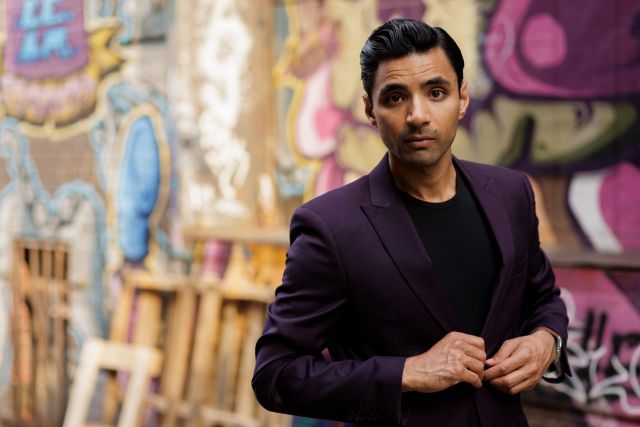
What is your favorite part of this role, which is so important in Mahabharata?
What I love most is that Yudhishthira carries so much weight—spiritually, emotionally, and physically. There’s a deep stillness to him, but that stillness is never passive. It’s like holding a storm in your chest and trying not to let it show.
The dice game scene is where all of that tension finally erupts. You can feel his body betraying his ideals—his breath tightening, his spine collapsing, his hands twitching toward the dice even as his mind screams “stop.” That physical unraveling was something I had to build in slowly, and it’s one of the most intense, rewarding parts of the role. It’s not a sword fight, but it’s absolutely a battle.
Also—what a gift, as an actor, to be born and to die in the same show. To track one man’s full arc across decades, from idealistic prince to weary philosopher-king—it’s the kind of role you dream of. A marathon in two parts.
How different is it from the other roles you’ve played in your career?
Let’s put it this way: I’ve played a lot of guys who solve their problems with sarcasm, denial, or the occasional romantic monologue. Yudhishthira is none of those things. This role asked something new of me—not just as an actor, but as a person. I had to tap into a stillness, a restraint, a weight of responsibility. And then I had to throw that all into chaos when he loses control. It’s not just different from other roles, it’s made me better for them. I feel like I’ll come out of this project with a much sharper sword (metaphorically… and maybe literally?)
What lessons can viewers take from the life of Yudhishthira?
The biggest one? That wisdom without humility can be dangerous.
Yudhishthira teaches us that being “right” doesn’t always lead to the right outcome. Sometimes doing the moral thing is not the smart thing, and doing the smart thing doesn’t feel very moral. He lives in that grey area where so many of us find ourselves, especially now. I think audiences walk away realizing that even the most idealistic person can mess up—and maybe that’s comforting. It means there’s space for us all to learn, to fall, to rise, and maybe to forgive ourselves.
As a South Asian actor, how difficult has it been to access success in Canada?
It’s been a journey. I consider myself incredibly fortunate to have carved out space in an industry that, for the first ten years of my career, often felt like it was working against me. What kept me going were the individuals within it—directors, writers, producers, and casting teams—who believed in me early on and helped me find a way through. But even then, the roles and projects weren’t exactly earth-shattering.
Mahabharata is a turning point. It’s a show where I don’t have to translate my culture for an audience—I get to live inside it. And even better, I get to share it. To bring a deeply South Asian story to national and international stages, without explanation or apology, is something I don’t take for granted. It hasn’t always been easy. But moments like this feel like something is finally cracking open.
https://www.lincolncenter.org/series/summer-for-the-city/mahabharata-148
Related Article
Feroz Abbas Khan – the Man Who Brought Mughal-e-Azam to America
